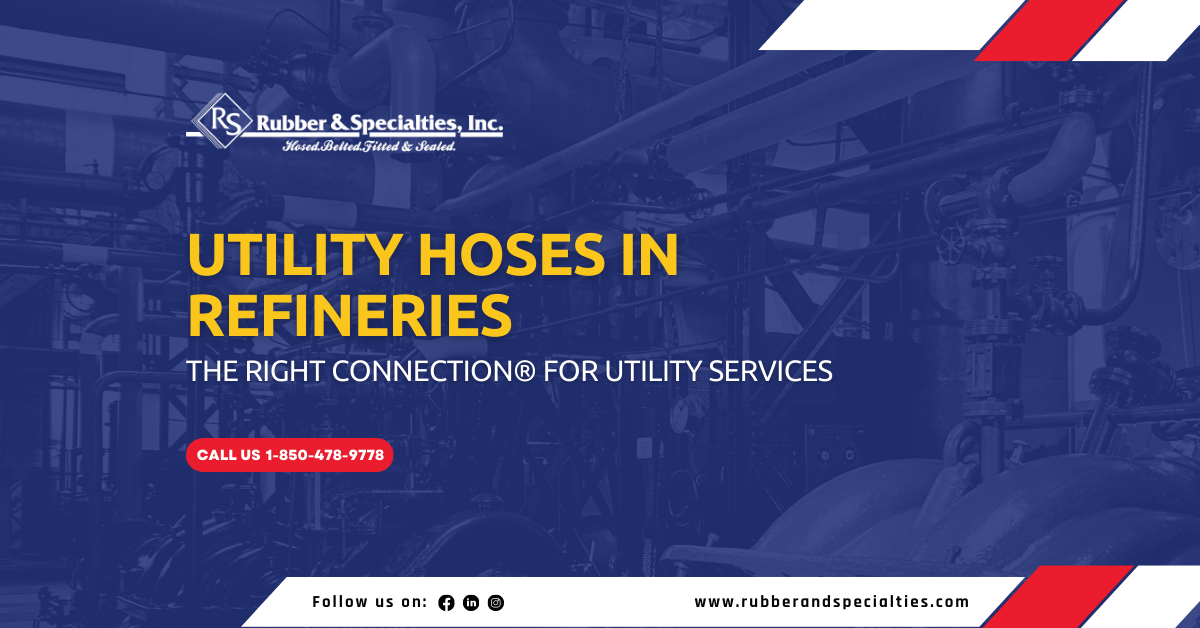
Utility Hoses in Refineries
We know what products are made from a barrel of crude oil and the general overview of crude oil, refined, but the different fluid transfer components required in oil refineries are often overlooked.
There are 130 operable petroleum refineries in the U.S. These refineries range in size and processing capacity. For example, the Talley Asphalt Products refinery in Kern, California, has a capacity of 1,700 barrels of crude oil per day, while Motiva’s refinery in Port Arthur, Texas, can refine 626,000 barrels per day. Based on these numbers, it is obvious a copious amount of petroleum has to be moved through an extensive processing plant in a timely manner. This requires a vast piping system and strong, efficient hose connections. Utility stations play a vital role in this process.

Utility Stations
One of the most common ways plant operators interact with process facilities is through utility stations. Utility stations are designed to help other process and maintenance areas in a plant get the necessary supply of nitrogen, plant air, steam, and water.
Each utility is given a different type of connection at the station. The distinctive connector, and sometimes color, of each hose, makes mismatching the utility being connected to the process unlikely. Utility stations are distributed throughout the plant to supply utility services with approximately 50 feet of hose (15 meters).
Use of Utility Services
Utility hoses are sometimes referenced using the acronym SWAN, which stands for steam, water, air, and nitrogen.
The largest sector of a utility station is steam, which is used to clean vessels, heat parts of vessels, and to clean heat exchanger tubes. Ground joints are utilized for this process.
Water is another element available at utility stations. It is used to clean shell and heat exchanger tubes, along with the general cleaning of floors and vessels. Standard cam & groove couplings along with Dixon’s EZ Boss-Lock cam & groove couplings can be used here.
Air is also available at utility stations. Just like water, air is also used to clean shell and heat exchanger tubes. In addition, air is used to clean plate heat exchanger tubes and tanks. Dixon’s Air King® couplings play a vital role in this process.
Last but not least, nitrogen is provided at utility stations because it is an inert gas used for maintenance in refineries. When a vessel is removed from service, nitrogen is used to purge the gas from the vessel. All of the nitrogen must be removed before the maintenance process can begin. Dixon offers Dix-Lock N-series and Dual-Lock P-series couplings for use with nitrogen at a utility station.
The Right Connection® for Utility Services
Connecting hoses to the utility station requires proper fittings for the application. Dixon provides a variety of connections for utility hoses in refineries.
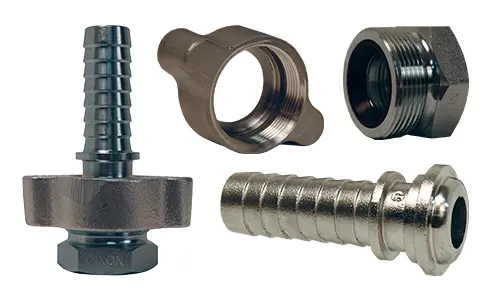
Dixon Boss® ground joints can be used with steam. They are available as couplings with female spuds, male spuds, stems, wing nuts, knurled nuts, and double spuds.
Features:
- Positive metal-to-polymer seal
- Leakproof seal forms when the metal head of the stem makes contact with the patented polymer seat in the spud
- Non-metallic polymer seat resists most chemicals found in manufacturing facilities
- Easy to seal
- Use with Boss clamps
Specification:
- Recommended for steam service up to 450°F (232°C)
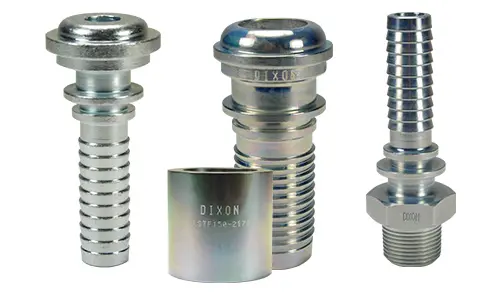
These bite-to-wire ferrules offer long-lasting fitting retention since the bite-to-wire is along the full barb versus just a couple at the top.
Features:
- No-skive fitting system for ease of fabricating hose assemblies
- Positive metal-to-polymer seal in ground joint couplings
- Non-metallic polymer seal resists most chemicals found in manufacturing facilities
- Leakproof seal forms when the metal head of the stem makes contact with the patented polymer seat in the spud
Specifications:
- Temperature range: -40°F (-40°C) to 450°F (232°C)
- Benchmark Mil-Spec 29210E and ISO 4023/6134 standards
- Test methodology simulates transfer applications as defined in industrial operations
- Coupling procedures for specific hose brands are available at dixonvalve.com
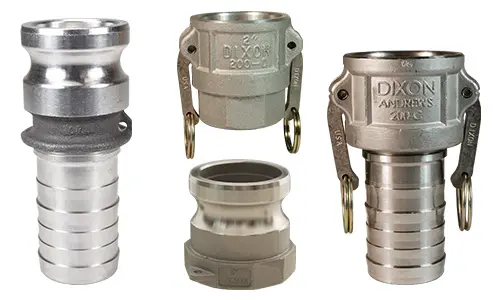
Along with a multitude of other applications, Dixon Cam & Groove couplings are used to transfer water at utility stations in refineries.
Features:
- Precision machined to rigid tolerances
- Durable stainless steel cam arm pins will not rust or bind providing greater strength and safety
- Recess holds gasket firmly in place to ensure proper placement
- Long shank design allows proper banding, thus eliminating the major cause of hose damage
Specifications:
- Produced to interchange with all product produced to Commercial Item Description A-A-59326D
- No standard exists for the 1/2” and 8” fittings, and generally these sizes do not interchange with other manufacturers
- Dust caps and dust plugs are not to be used in pressure applications for safety and environmental reasons
- Designed for use with liquids, consult Dixon for specific recommendations
- Refer to the specifications section of the Cam & Groove Couplings and Accessories catalog for pressure ratings
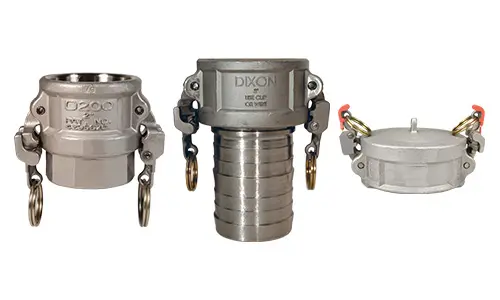
Manufactured at Dixon Specialty Products in Chestertown, Maryland, these cam and groove couplings are proven with trusted reliability since 1994.
With Dixon’s EZ Boss-Lock couplings, there is no more fumbling with clamps, wire, clips, or pins. The couplings are ergonomic and easy to use. Simply close the handles and the locking mechanism is engaged. You will hear and feel the coupling lock. The release lever, which is under your thumb, opens in the direction opposite the cam arm. The couplings are also resistant to accidental disconnection when dragged.

Dixon’s Dix-Lock N-series are used on utility air, water, and nitrogen lines, making them an ideal connection for utility hoses in refineries. The N-series contains a locking sleeve that threads to the bottom of the sliding sleeve of the coupler to prevent accidental disconnection.
Sizes:
- 3/8” and 1/2” body sizes
- 3/8” through 1” end connections
Features:
- Non-valved, full-flow design
- Convenient push-twist-click connection
- Enhanced safety with locking sleeve
- Low profile prevents hose snags
- Highly versatile end configuration selection
- Optional staked on ferrule
Specifications:
- Rated to 300 PSI in brass and 500 PSI in 202 stainless steel at ambient temperature
- -40°F (-40°C) to 250°F (121°C)
- Interchange data:
- Bowes 51000-Series
- National Series ‘B’
- MacDonald Quick Action
- Campbell Single-Lock
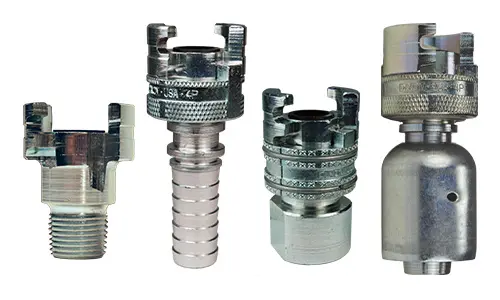
Dixon’s P-series are a full-flow, quick-acting coupling used on utility air, water, and nitrogen lines.
Sizes:
- 1/2” body size
- 3/8” through 1” end connections
Features:
- Unisex design
- Any dual-lock coupler of the same size will connect
- Convenient pull/pull and twist to connect and disconnect
- Spring-loaded interlocking engagement
- Corrosion-resistant coating
- Smooth I.D. permits full flow paths to tool
- Highly versatile end configuration selection
- Optional locking key prevents accidental sleeve retraction
- Optional staked on ferrule
Specifications:
- Working pressure up to 300 PSI
- Operating temperatures between -40°F (-40°C) and 250°F (121°C)
- Locking key part number: 4P-CLIP
- Interchange data:
- Thor PHC Series
- National Brands Series A
- Dual-Lock
- Campbell Double Lock
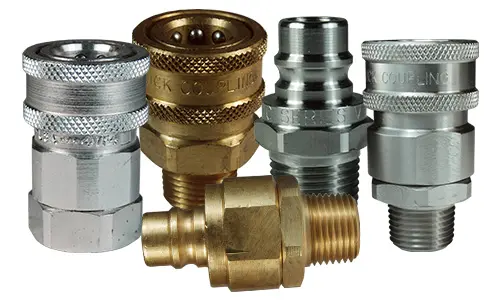
Dixon’s V-Series are a highly versatile general-purpose coupling for a variety of applications.
Sizes:
- 1/4” to 2”
Features:
- Available in combinations of valved and unvalved
- Coupler locking sleeve option available to prevent accidental disconnection
- Tubular ‘TV’ valves are designed for optimum performance in pneumatic applications
- ROHS-compliant trivalent chrome plating
Specifications:
- Interchangeable to MIL-C-51234, Snap-Tite H/IH, Faster TNV/TNL, and SH Stucchi
- Thread configurations: female NPTF, male NPTF, and male JIC
- Temperature range: -40°F (-40°C) to 250°F (121°C) with standard seals
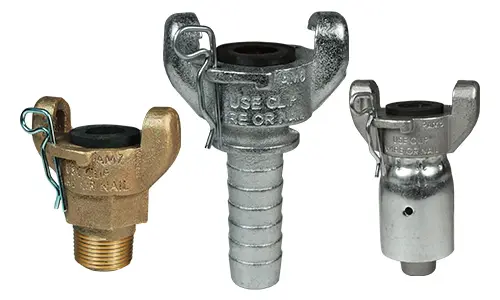
Dixon Air King couplings are recommended for use on air lines for virtually any type of pneumatic equipment.
Features:
- Universal head identical for all parts within the 1/4” to 1” range
- Any two fitting fittings within that range can be directly connected regardless of hose shank or threaded size
- The ferrule comes attached to the fitting for easy installation
- Ferrules can be swaged or crimped depending on your coupling installation equipment
Specifications:
- The maximum recommended working pressure is 150 PSI or less at ambient temperature (70°F or 21°C)
Although Air King couplings may interchange with other manufacturers’ fittings, we do not recommend their use with other products. Not all locking heads are made to the same standards as Dixon Air King. Use with other brands of fittings may create an unsafe condition, due to poor design or worn equipment. In addition, the use of an Air King safety clip or wire-type retainer is necessary to ensure Air King universal couplings will not become accidentally disconnected. This guarantees the fittings are properly connected because the safety pin will not go through the holes in mating flanges until couplings are locked in place. Only one Air King safety clip or wire-type retainer is required for each Air King universal coupling.
Summary
Refineries are an integral part of the U.S. economy, infrastructure, and our daily lives. The ability to transfer crude oil through the various aspects of the refining process is crucial and must be handled with care. Utility stations in refineries provide easy access to the necessary utilities to keep things running smoothly. Having the proper hose fittings at these utility stations ensures the oil refining process remains safe and efficient throughout the plant.
SOURCE: https://blog.dixonvalve.com/utility-hoses-in-refineries

